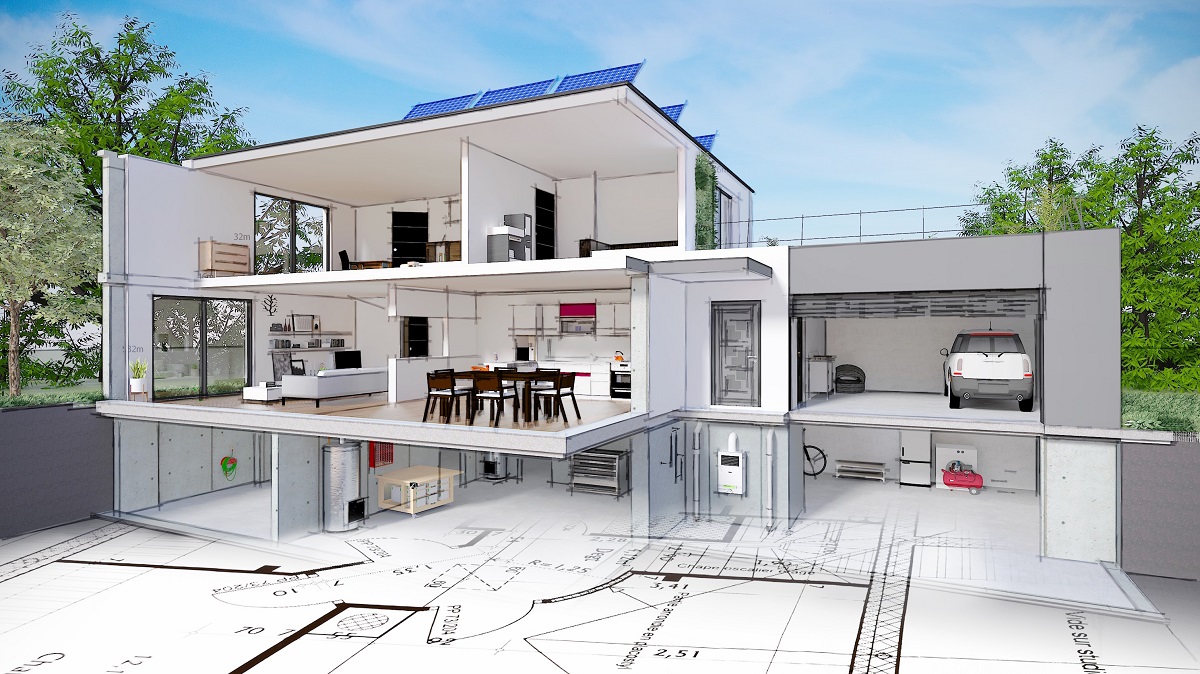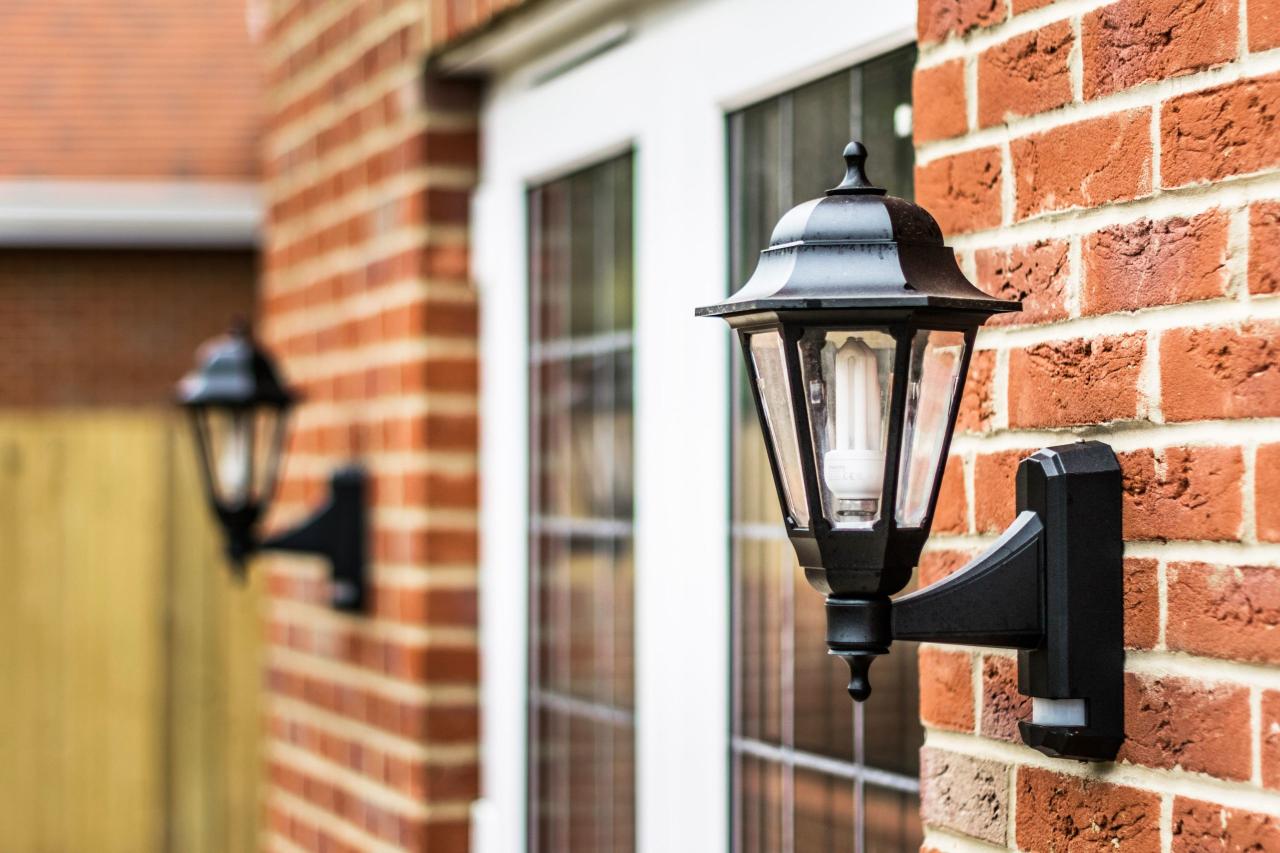Achieving a sustainable and smart home interior design represents a significant shift in how we approach living spaces. It’s about creating homes that are not only aesthetically pleasing and technologically advanced but also environmentally responsible and energy-efficient. This exploration delves into the core principles of sustainable and smart design, examining material selection, energy optimization strategies, and the seamless integration of smart home technology.
We will uncover innovative solutions that minimize environmental impact while enhancing comfort and convenience.
The journey towards a sustainable and smart home involves a holistic approach, encompassing everything from the materials used in construction to the energy consumption patterns of daily life. This requires careful consideration of various factors, including material sourcing, energy efficiency measures, and the implementation of smart home technologies. By understanding these elements and their interplay, we can design homes that are both beautiful and environmentally conscious, reflecting a responsible and forward-thinking approach to living.
Defining Sustainable and Smart Home Design Principles
Sustainable and smart home design represents a significant shift in how we approach interior spaces, prioritizing both environmental responsibility and technological integration for enhanced comfort and efficiency. This approach moves beyond mere aesthetics, encompassing a holistic view of the home’s impact on the planet and its inhabitants.
Core Principles of Sustainable Interior Design
Sustainable interior design prioritizes the selection of eco-friendly materials and the optimization of energy efficiency within the home. Material selection involves choosing products with minimal environmental impact throughout their lifecycle, from sourcing raw materials to manufacturing, transportation, and eventual disposal or recycling. Energy efficiency focuses on reducing the home’s energy consumption through design choices that maximize natural light, minimize heat loss or gain, and utilize energy-efficient appliances and lighting systems.
This approach minimizes the home’s carbon footprint and reduces operational costs for homeowners.
Key Features of Smart Home Technology in Interior Design
Smart home technology plays a crucial role in achieving sustainable and efficient interior spaces. Automated lighting systems, for example, use sensors to adjust lighting levels based on occupancy and ambient light, reducing energy waste. Similarly, smart thermostats learn occupant preferences and adjust heating and cooling accordingly, optimizing energy use and improving comfort. Other relevant technologies include smart appliances that monitor and regulate energy consumption, and automated window coverings that manage sunlight and insulation.
These technologies not only enhance convenience but also contribute significantly to energy savings and reduced environmental impact.
Comparison of Traditional, Sustainable, and Smart Design Approaches
Traditional design approaches often prioritize aesthetics and immediate comfort without necessarily considering the long-term environmental consequences or the potential for technological integration. Sustainable and smart design, in contrast, integrate these considerations from the outset. Traditional designs may use materials with high embodied carbon, rely heavily on artificial lighting and heating/cooling, and lack the energy-saving features offered by smart technologies.
Sustainable and smart design emphasizes the use of recycled and renewable materials, passive design strategies to optimize natural light and ventilation, and the integration of smart technologies to enhance efficiency and reduce waste. The result is a home that is both aesthetically pleasing and environmentally responsible.
Environmental Impact of Common Building Materials
The following table compares the environmental impact of various building materials commonly used in home interiors. The impact is assessed based on factors such as embodied carbon, resource depletion, and recyclability. Note that these are general comparisons and the specific impact can vary depending on the sourcing, manufacturing processes, and transportation distances involved.
| Material | Embodied Carbon (kg CO2e/m²) | Resource Depletion | Recyclability |
|---|---|---|---|
| Concrete | High (varies greatly depending on cement type and mix design) | High (cement production is resource-intensive) | Low (often ends up in landfill) |
| Wood (FSC Certified) | Moderate to Low | Moderate (depending on forestry practices) | Moderate to High (depending on type and processing) |
| Bamboo | Low | Low (fast-growing, renewable resource) | Moderate |
| Recycled Steel | Low | Low (recycled content reduces resource demand) | High |
Material Selection for Sustainable Interiors
Choosing sustainable materials is paramount in creating a truly eco-friendly and healthy home environment. The impact of our interior design choices extends far beyond aesthetics; it significantly influences the overall environmental footprint of our living spaces. By prioritizing materials with low environmental impact and long lifespans, we can minimize resource depletion and reduce waste.
Eco-Friendly Materials for Flooring, Wall Coverings, and Furniture
The selection of materials for flooring, wall coverings, and furniture significantly impacts a home’s sustainability. Opting for eco-friendly alternatives reduces the environmental burden associated with manufacturing, transportation, and disposal.
- Flooring: Bamboo, cork, recycled rubber, reclaimed wood. Bamboo is a rapidly renewable resource, offering durability and a beautiful aesthetic. Cork is harvested without harming the tree, providing excellent insulation and comfort. Recycled rubber offers resilience and durability, diverting waste from landfills. Reclaimed wood provides a unique character while reducing the demand for newly harvested timber.
- Wall Coverings: Natural paints (low-VOC), reclaimed wood paneling, recycled glass tiles, natural wallpaper (cork, grasscloth). Natural paints minimize the release of volatile organic compounds (VOCs) which can negatively impact indoor air quality. Reclaimed wood offers a rustic charm, and recycled glass tiles add a touch of elegance while promoting resource conservation. Natural wallpapers provide texture and visual interest using renewable materials.
- Furniture: Reclaimed wood, bamboo, sustainably harvested hardwoods (FSC certified), recycled metal, upcycled materials. Reclaimed wood offers unique character and reduces the need for new lumber. Bamboo is a rapidly renewable resource, ideal for furniture construction. Sustainably harvested hardwoods, certified by the Forest Stewardship Council (FSC), ensure responsible forest management. Recycled metal adds a modern industrial touch, diverting waste from landfills.
Upcycled materials give new life to discarded items, reducing waste and promoting creativity.
Sourcing and Lifecycle Impact of Materials
Understanding the sourcing and lifecycle impact of materials is crucial for making informed, sustainable choices. This involves considering the environmental costs associated with extraction, processing, transportation, use, and disposal.Recycled and renewable materials offer significant advantages. Recycled materials divert waste from landfills, reducing the need for virgin resources. Renewable materials, such as bamboo and cork, replenish naturally, minimizing the depletion of finite resources.
The lifecycle impact should be assessed through a life cycle assessment (LCA), which quantifies the environmental burdens associated with a product’s entire life. For example, a wooden chair made from sustainably sourced wood will have a lower carbon footprint than one made from rapidly grown plantation timber with intensive chemical treatments.
Innovative and Sustainable Material Applications
Contemporary interior design increasingly incorporates innovative and sustainable materials. Mycelium, a mushroom root structure, is being used to create sustainable building materials, including panels and insulation. These materials are lightweight, biodegradable, and possess excellent insulation properties. Seaweed is emerging as a versatile material for textiles and insulation, offering a renewable and sustainable alternative. Hempcrete, a mixture of hemp fibers and lime, is gaining popularity as a sustainable building material with excellent insulation and breathability.
These examples demonstrate the potential of bio-based materials to revolutionize interior design.
Certifications and Labels for Sustainable Materials
Several certifications and labels help consumers identify sustainable materials and products. These certifications ensure that materials are sourced responsibly and meet specific environmental standards.
- Forest Stewardship Council (FSC): Certifies wood and paper products from responsibly managed forests.
- Sustainable Forestry Initiative (SFI): Promotes sustainable forest management practices.
- LEED (Leadership in Energy and Environmental Design): A green building rating system that considers material sustainability.
- Cradle to Cradle CertifiedTM: A certification program that assesses the environmental and social impact of products throughout their lifecycle.
- Global Organic Textile Standard (GOTS): Certifies organic textiles, ensuring environmentally and socially responsible production.
Energy Efficiency and Smart Home Integration
Smart home technology offers a powerful pathway towards significant energy savings and a reduced environmental footprint. By intelligently managing energy consumption across various home systems, we can create a more sustainable and comfortable living environment. This integration leverages automation and data analysis to optimize resource use, ultimately leading to both cost and carbon emission reductions.
Smart Home Technology’s Role in Optimizing Energy Consumption
Smart home technology plays a crucial role in optimizing energy consumption across various aspects of the home. For example, smart lighting systems can automatically adjust brightness based on occupancy and ambient light levels, eliminating wasted energy from unnecessarily illuminated spaces. Similarly, smart thermostats learn user preferences and adjust heating and cooling schedules accordingly, minimizing energy use while maintaining comfortable temperatures.
Smart appliances can also be programmed to operate during off-peak hours, reducing demand charges and overall energy consumption. Consider a scenario where a smart thermostat learns that residents typically leave for work at 8 am and return at 6 pm. It automatically adjusts the temperature during the day, saving energy without compromising comfort upon return.
Integrating Renewable Energy Sources into Home Design
Integrating renewable energy sources like solar and wind power into home design is a key step towards achieving energy independence and reducing reliance on fossil fuels. Solar photovoltaic (PV) panels can be seamlessly integrated into the roof design, converting sunlight into electricity. Wind turbines, while more suitable for larger properties or areas with consistent wind, can also provide a sustainable energy source.
The integration of these systems often involves careful consideration of roof orientation, shading, and wind patterns to maximize energy generation. A well-designed solar panel system, for example, can significantly offset a home’s energy consumption, potentially leading to zero or even negative energy bills.
Energy Savings and Reduced Carbon Footprint with Smart Thermostats and Lighting
Smart thermostats offer significant energy savings by learning occupant behavior and adjusting temperatures accordingly. Features like geofencing, which automatically adjusts the temperature based on the occupants’ location, further optimize energy use. Similarly, smart lighting systems equipped with occupancy sensors and dimming capabilities reduce energy waste by only illuminating spaces when and as needed. These systems contribute to a reduced carbon footprint by lowering overall energy consumption, translating directly into fewer greenhouse gas emissions.
Studies have shown that smart thermostats can reduce energy consumption by up to 15%, while smart lighting systems can achieve savings of up to 30%, depending on usage patterns and system design.
Implementing Energy-Efficient Lighting Solutions
Implementing energy-efficient lighting solutions involves a step-by-step process focusing on both technology and mindful usage.
- Assessment: Begin by assessing your current lighting needs and usage patterns. Identify areas where lighting is inefficient or excessive.
- Technology Selection: Choose energy-efficient lighting options such as LED bulbs, which consume significantly less energy and have longer lifespans compared to incandescent or fluorescent bulbs.
- Installation: Replace existing bulbs with LED equivalents, ensuring proper fixture compatibility.
- Control Integration: Integrate smart lighting controls, including dimmers and occupancy sensors, to further optimize energy consumption.
- Maintenance: Regularly check and maintain your lighting system to ensure optimal performance and prevent premature failure.
Smart Home Technology and Interior Aesthetics: Achieving A Sustainable And Smart Home Interior Design
The seamless integration of smart home technology is crucial for achieving a truly sustainable and stylish home. A well-designed smart home shouldn’t feel cluttered with gadgets; instead, technology should enhance the aesthetic appeal while improving functionality and user experience. Minimalist design principles, coupled with careful device placement, are key to achieving this balance.Smart home technology offers significant opportunities to improve both the functionality and aesthetic appeal of a home interior.
By carefully selecting and integrating devices, homeowners can create a space that is both beautiful and highly efficient. This section explores various aspects of this integration, addressing potential challenges and providing practical solutions.
Aesthetic Integration of Smart Home Devices
Seamless integration requires a thoughtful approach to device placement and selection. Smart devices should complement, not clash with, the existing décor. For example, discreetly placed smart speakers can blend into bookshelves or corners, while smart lighting systems can be integrated into existing light fixtures, maintaining a clean and uncluttered look. Minimalist designs, characterized by clean lines and neutral colours, often provide the ideal backdrop for smart home technology, allowing the devices to recede into the background and become less visually prominent.
Choosing devices with sleek, modern designs that complement the overall aesthetic is paramount.
Examples of Smart Home Technology Enhancing Interior Functionality and User Experience
Smart thermostats, for instance, learn user preferences and automatically adjust temperatures, optimizing energy efficiency and comfort. Smart lighting systems allow for customized lighting schemes to suit different moods and activities, enhancing the ambiance of each room. Integrated security systems provide peace of mind and can be controlled remotely, improving safety and convenience. Furthermore, smart appliances, like refrigerators with inventory management features, streamline daily tasks and minimize waste.
A smart home hub can centralize control of these various systems, creating a unified and user-friendly experience. Imagine effortlessly adjusting the lighting and temperature from your smartphone as you settle into the living room after a long day.
Challenges in Integrating Smart Home Technology into Existing Homes and Solutions
Retrofitting smart home technology into older homes can present challenges, particularly regarding wiring and infrastructure. Existing electrical systems might not be compatible with certain smart devices, requiring upgrades or professional installation. Addressing compatibility issues between different smart home brands and protocols is also crucial for a seamless system. Solutions include working with experienced smart home installers who can assess the existing infrastructure and recommend suitable upgrades or workarounds.
Using wireless communication protocols, such as Zigbee or Z-Wave, can often overcome wiring limitations. Careful planning and professional guidance are key to successful integration in existing homes.
Smart Home Device Placement in Various Room Types
The living room could feature a sleek, minimalist smart speaker integrated into a bookshelf, its presence barely noticeable yet providing voice control over lighting, music, and temperature. In the bedroom, smart lighting integrated into bedside lamps could offer customizable wake-up routines with gradually increasing brightness, creating a gentler transition into the day. The kitchen could benefit from smart appliances, such as a smart refrigerator displaying inventory and suggesting recipes based on available ingredients, all integrated seamlessly into the kitchen cabinetry.
These examples showcase how thoughtful placement and selection can maintain a home’s aesthetic appeal while enhancing its functionality. Imagine a kitchen where a smart display integrated into the backsplash provides quick access to recipes and timers, all while maintaining the overall aesthetic of the space.
Sustainable Practices Throughout the Design Process

Source: earth911.com
Creating a truly sustainable and smart home requires careful consideration of environmental impact throughout the entire design process, from initial concept to final implementation and beyond. Minimizing waste, selecting responsible materials, and promoting conscious consumption are crucial elements in achieving this goal. This extends beyond simply choosing eco-friendly products; it encompasses a holistic approach that prioritizes resource efficiency and responsible disposal at every stage.Sustainable practices are not merely an add-on; they are integral to the success of any environmentally conscious design project.
The choices made during the design phase significantly influence the long-term environmental footprint of the home. By actively incorporating sustainable practices, designers can contribute to a more responsible and resilient built environment.
Waste Reduction and Responsible Disposal During Renovations and Construction
Waste generation is a significant concern in the construction and renovation industries. The responsible management of construction and demolition waste (CDW) is crucial for minimizing environmental impact. This involves careful planning to reduce waste at the source, implementing efficient sorting and recycling systems, and ensuring the proper disposal of non-recyclable materials. Strategies include pre-construction waste audits to identify potential waste streams, the use of prefabricated components to minimize on-site waste, and the selection of materials with high recycled content.
Furthermore, partnering with reputable waste management companies specializing in CDW recycling and responsible disposal is essential. For example, a project might divert 90% of CDW from landfills by employing these methods, significantly reducing the volume of waste sent to landfills.
Minimizing the Environmental Impact of Furniture and Decor Manufacturing and Transportation
The manufacturing and transportation of furniture and decor significantly contribute to a project’s carbon footprint. Choosing locally sourced, sustainably manufactured furniture and decor items reduces transportation emissions. Supporting manufacturers committed to sustainable forestry practices, responsible sourcing of materials, and low-emission production processes is vital. Consideration should also be given to the lifecycle of these items; durable, repairable, and recyclable furniture is preferred over disposable options.
For instance, opting for furniture made from reclaimed wood reduces the demand for newly harvested timber, thus preserving forests. Furthermore, choosing furniture with minimal packaging reduces waste and transportation needs.
The Interior Designer’s Role in Promoting Sustainable and Responsible Consumption Habits, Achieving a sustainable and smart home interior design
The interior designer plays a pivotal role in guiding clients toward sustainable choices. This involves educating clients about the environmental impacts of different materials and products, promoting the benefits of sustainable design, and offering alternatives that align with their values and budget. Designers can advocate for the use of recycled and reclaimed materials, support local artisans and manufacturers, and promote the principles of circular economy design – designing for durability, repairability, and recyclability.
For example, a designer might suggest using reclaimed barn wood for flooring instead of newly harvested timber, or source locally made textiles, reducing transportation emissions and supporting local businesses. Furthermore, designers can help clients understand the long-term cost savings associated with sustainable choices.
Sustainable Design Process Flowchart
The sustainable design process can be visualized as a flowchart. It begins with the initial client consultation and project briefing, where sustainability goals are established. This is followed by a thorough site analysis and material selection, emphasizing sustainable options. The design development phase integrates sustainable design principles, considering energy efficiency, waste reduction, and responsible material sourcing. Detailed construction documents are then prepared, incorporating sustainable building practices.
The construction phase meticulously monitors waste management and material usage. Finally, post-occupancy evaluation assesses the building’s performance and identifies areas for improvement. This iterative process ensures continuous improvement and adaptation.
Case Studies of Sustainable and Smart Homes
This section presents detailed case studies of homes successfully integrating sustainable and smart design principles. Analyzing their design choices, technologies, and environmental impact allows for a comparative assessment against conventional homes, highlighting the benefits of sustainable and smart home design.
The Passive House in Freiburg, Germany
This passive house exemplifies a highly energy-efficient design. Its key features include exceptionally high levels of insulation, airtight construction, triple-glazed windows, and a heat recovery ventilation system. The home utilizes solar panels for electricity generation and a geothermal heat pump for heating and cooling. This combination significantly reduces reliance on the grid, minimizing its carbon footprint. The home’s design prioritizes natural light and ventilation, reducing the need for artificial lighting and air conditioning.
Compared to a conventional home of similar size, the Freiburg Passive House boasts a drastically reduced energy consumption, estimated to be up to 90% lower. This translates to substantial savings on energy bills and a significantly smaller environmental impact.
The Zero Energy Home in California
Located in a sunny region of California, this zero-energy home showcases the effective integration of solar energy and energy-efficient design. Its design incorporates photovoltaic panels on the roof, generating sufficient electricity to meet the home’s annual energy needs. Passive solar design elements, such as strategically placed windows and overhangs, maximize natural light and minimize heat gain. High-efficiency appliances and LED lighting further contribute to its energy efficiency.
Water conservation measures include rainwater harvesting and drought-tolerant landscaping. The overall environmental impact is minimal, with zero net energy consumption and a reduced water footprint. Compared to a typical California home, its energy consumption is significantly lower, approaching zero net energy usage.
The Smart Home in Amsterdam, Netherlands
This smart home in Amsterdam integrates advanced technology for energy management and home automation. The home utilizes smart thermostats, lighting systems, and appliances that are controlled through a central system, allowing for optimized energy usage based on occupancy and preferences. Smart sensors monitor energy consumption in real-time, providing data for informed decision-making. The home also incorporates a rainwater harvesting system for irrigation and greywater recycling for non-potable uses.
While not entirely off-grid, its smart technology allows for significant energy savings compared to a conventional home, resulting in lower energy bills and a reduced carbon footprint. The home’s sustainability is enhanced by the use of recycled and locally sourced materials in its construction.
Floor Plan of a Sustainable and Smart Home
Imagine a two-story home with a south-facing orientation to maximize solar gain. The ground floor features an open-plan living area with large, energy-efficient windows, allowing ample natural light. A smart thermostat automatically adjusts the temperature based on occupancy and external conditions. The kitchen incorporates energy-efficient appliances and a rainwater harvesting system for irrigation. A solar panel array on the roof is visually integrated into the design.
Upstairs, bedrooms are designed for optimal natural ventilation. Smart lighting systems adjust brightness based on ambient light levels. A central control system manages all smart home technologies, providing real-time energy consumption data and allowing for remote control of various functions. The landscaping includes drought-tolerant plants, minimizing water consumption. Recycled and sustainable materials are used throughout the construction.
This design integrates passive and active strategies for energy efficiency and utilizes smart technology for optimized resource management.
Ending Remarks
Ultimately, achieving a sustainable and smart home interior design is not just about adopting new technologies or using eco-friendly materials; it’s about embracing a mindful approach to living. By prioritizing energy efficiency, responsible material sourcing, and thoughtful design choices, we can create homes that are both comfortable and environmentally responsible. The integration of smart home technology further enhances this vision, allowing for optimized energy consumption and improved user experience.
The future of home design lies in this harmonious blend of sustainability, technology, and aesthetic appeal, creating spaces that are both beautiful and beneficial for the planet.
Essential FAQs
What are the initial costs associated with building a sustainable and smart home?
Initial costs can be higher than traditional builds due to premium materials and smart technology, but long-term savings on energy and maintenance often offset this.
How can I make my existing home more sustainable and smart?
Retrofitting is possible! Start with energy-efficient lighting and appliances, consider smart thermostats, and gradually incorporate sustainable materials during renovations.
What happens if my smart home system malfunctions?
Most systems have backup power and remote troubleshooting capabilities. Professional installation and maintenance contracts can mitigate risks.
Are there government incentives for sustainable home improvements?
Many governments offer tax credits or rebates for energy-efficient upgrades and renewable energy installations; check your local programs.
How do I choose the right smart home system for my needs?
Consider your budget, desired level of automation, and compatibility with existing systems. Research different platforms and seek professional advice.
- 17+ Aplikasi VCS Gratis Tanpa Koin APK VC Mod Acak Online - December 13, 2025
- TikTok Followers Gratis Paling Aman Tanpa Login & Password - December 13, 2025
- Cara Akses Konten Video yang Terblokir dengan Blockaway Proxy - December 13, 2025









